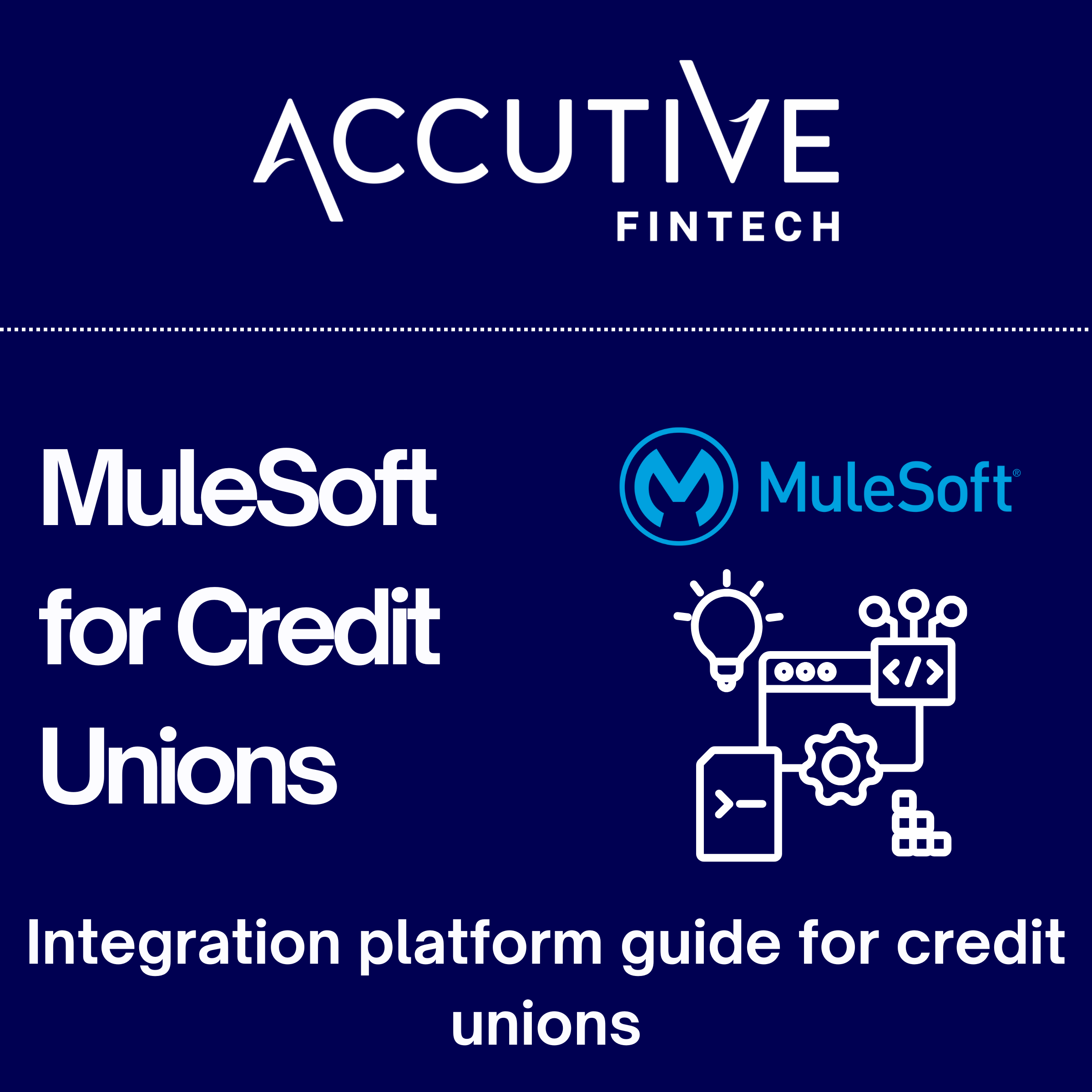Across the financial services industry, MuleSoft has long been a cornerstone for connecting systems, data, and experiences. Its API-led integration model allows banks and credit unions to modernize legacy architectures and streamline customer journeys. MuleSoft’s presence in the Salesforce ecosystem also helps bolster its popularity among financial institutions that use Salesforce CRM.
Despite MuleSoft’s numerous advantages as an advanced iPaaS platform, many financial institutions, particularly community banks and credit unions are running into challenges. As integration environments grow in size and complexity, many FIs find themselves struggling to manage, scale, and modernize their MuleSoft practice. Instead of adopting the platform’s newest capabilities, including agentic AI and next-generation automation, many smaller FIs are struggling just to keep their current implementation afloat.
The Challenge: When Integration Becomes Its Own Bottleneck
MuleSoft’s flexibility is one of its greatest strengths; however, that same flexibility can create operational complexity that spirals quickly without a clear governance framework or a well-defined integration strategy.
What begins as a straightforward API-led integration approach often evolves into a sprawling ecosystem of services, systems, and teams: all moving at different speeds, with different priorities. Over time, what was meant to simplify becomes a barrier to agility.
Fragmented API Portfolios
In many financial institutions, integration projects are initiated in silos: one API at a time, often by different teams or departments. Without a unified catalog or consistent design standards, APIs proliferate with minimal reuse or oversight.
Over the years, this leads to:
- Redundant APIs performing similar functions across business units.
- Versioning confusion, where multiple versions of the same service coexist.
- Orphaned APIs that remain deployed but unused, adding unnecessary complexity and cost.
This fragmentation undermines one of MuleSoft’s core promises: reusability. Instead of an interconnected ecosystem, teams end up managing a patchwork of integrations that are difficult to maintain, govern, and scale.
Resource Constraints
For many community banks and credit unions, maintaining a MuleSoft environment at enterprise standards is a challenge of both capacity and capability.
- Skilled MuleSoft architects and developers are in short supply, and competition from larger financial institutions drives up market rates.
- Internal IT teams often lack the bandwidth to handle both ongoing maintenance and new integration projects, leading to growing backlogs.
- As a result, strategic projects, such as core modernization or integrating new FinTechs, are delayed while teams focus on simply “keeping the lights on.”
Without sufficient MuleSoft expertise, institutions struggle to fully leverage the platform’s advanced features, performance optimization options, and governance tools. This limits ROI on the financial institution’s substantial investment into MuleSoft.
Mounting Total Cost of Ownership (TCO)
MuleSoft is a leading platform and when used effectively, it delivers enterprise-grade reliability and scalability. But unmanaged growth, limited reuse, and underutilized environments can quickly drive up costs.
- Licensing and infrastructure fees scale with the number of cores and APIs, meaning inefficient architectures directly impact spend.
- Over-provisioned environments and poor lifecycle management lead to wasted compute capacity and inflated cloud costs.
- Lack of governance results in inconsistent security controls, untracked API dependencies, and longer testing and deployment cycles.
The result: community banks and credit unions often find their integration budget expanding faster than their integration value. What should be a source of operational leverage becomes an ongoing cost burden.
The Missed Opportunity: Limited Adoption of New Features
MuleSoft continues to innovate with some exceptionally useful new features, including the introduction of AI-assisted development, automated integration mapping, and enhanced governance through tools like Einstein Copilot and agentic AI. Yet, many financial institutions are unable to take advantage of these advancements.
Why? Because their current MuleSoft practice is already stretched thin. Teams are focused on routine maintenance and troubleshooting rather than platform modernization. Upgrading to the latest versions, adopting new tooling, or retraining staff often falls to the bottom of the priority list. The unfortunate consequence of this is a widening innovation gap.
While larger banks are leveraging AI to accelerate integration design, improve data quality, and reduce errors, smaller FIs risk being left behind by using yesterday’s integration models in a rapidly evolving digital landscape.
MuleSoft remains a powerful enabler of digital transformation, but without the right structure, strategy, and support, it can become its own form of technical debt. The institutions that thrive will be those that treat integration not just as a technical necessity, but as a governed, scalable capability aligned to business outcomes.
The Opportunity Ahead: Agentic AI and the Future of Integration
The next era of integration is intelligent, autonomous, and deeply data-driven. MuleSoft’s recent innovations, particularly its agentic AI capabilities, mark a fundamental shift in how financial institutions can design, deploy, and manage APIs.
Agentic AI brings automation, reasoning, and adaptability into the integration process. Rather than relying entirely on human developers, MuleSoft’s new AI-driven tools can:
- Automatically generate API specifications from natural language prompts
- Recommend optimal integration patterns and reusable components
- Detect and resolve data mapping or dependency issues in real time
- Continuously optimize API performance based on usage patterns
Ironically, financial institutions that are significantly resource constrained stand to benefit the most from the productivity and efficiency gains of Agentic AI. For institutions that adopt these capabilities, the productivity gains are significant. Accutive FinTech’s early adopter clients are reporting up to 50% faster development cycles and measurable improvements in reliability and governance.
However, realizing these benefits requires more than a simple upgrade. It demands a strategic modernization plan, the right governance structure, and skilled MuleSoft practitioners who understand both the technical platform and the unique regulatory and operational realities of financial services.
Why Smaller Financial Institutions Are Falling Behind
For community banks and credit unions, the challenge isn’t a lack of vision: it’s capacity. Many of these institutions adopted MuleSoft as part of a digital transformation initiative, but over time, their integration practices plateaued.
Without sufficient resources or specialized expertise, modernization projects are often postponed in favor of more immediate priorities.
- Version upgrades get delayed due to concerns about downtime or compatibility.
- AI-driven features remain unexplored because teams are busy managing daily incidents.
- Innovation budgets are consumed by maintenance costs, leaving little room for strategic investment.
This dynamic has left many smaller institutions stuck in what can be called integration limbo, operating a powerful enterprise-grade platform but using only a fraction of its potential.
How Accutive FinTech Helps Financial Institutions Realign Their MuleSoft Strategy
At Accutive FinTech, we help financial institutions get their MuleSoft investment back on track. Our team of certified MuleSoft architects and financial services integration experts works side by side with banks and credit unions to optimize, modernize, and scale their integration practice.
Our specialized MuleSoft services
Our team is comprised of MuleSoft for financial services experts that have deep expertise with the operational and compliance needs of banks and credit unions. Each of our services can be provisioned by onshore team, offshore or blended teams.
MuleSoft Practice Assessments and Optimizations
We assess your current MuleSoft implementation, identify redundancies, and help you establish a modern governance model, ensuring every API is cataloged, reusable, secure, and aligned with business priorities. We offer complimentary one-week MuleSoft assessments for banks and credit unions in the U.S. and Canada.
Managed MuleSoft Services
Accutive FinTech provides end-to-end managed services for MuleSoft environments, including platform administration, monitoring, and ongoing support. This allows your internal teams to focus on innovation rather than maintenance.
Platform Modernization & AI Enablement
We help institutions migrate to the latest MuleSoft versions and safely enable agentic AI and Einstein Copilot capabilities unlocking the benefits of automation and intelligent integration.
Strategic Integration Architecture
Our experts design and implement scalable architectures that support your digital transformation goals, whether you’re modernizing your core, expanding digital onboarding, or connecting to new fintech ecosystems.
Future-Ready Integration Starts with the Right Partner
Your MuleSoft practice should enable and empower innovation — not hinder it. When simply managing your MuleSoft system is a challenge, that is a red flag for the health of your digital transformation program. The good news? With the right strategy, governance, and expertise, your financial institutions can transform MuleSoft from a black box into a strategic enabler of digital growth.
Accutive FinTech helps banks and credit unions reduce complexity, control costs, and embrace the next generation of intelligent integration — paving the way for faster innovation and a stronger competitive edge.








